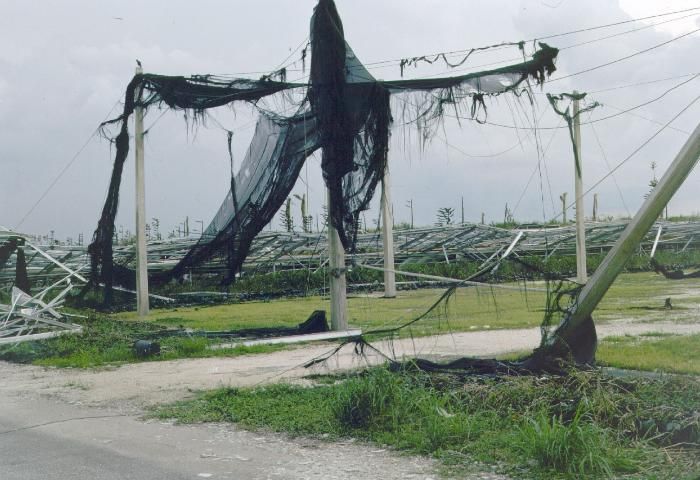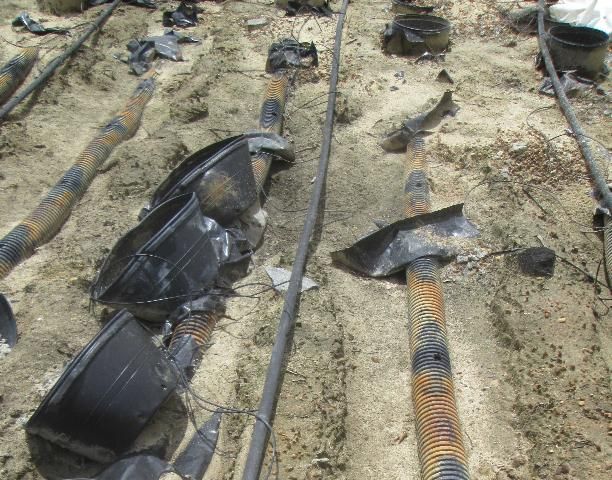We are busy professionals who probably do not think about the impact a hurricane may have on the nursery until one is coming our way. Completing a few tasks in advance will reduce the devastating impact that hurricanes can have on plant production and personnel. I have provided a list of items or tasks for you to complete prior to hurricane arrival. The first list of tasks should be completed a few months before hurricane season. The second list should be completed a few weeks before expected arrival, the third list should be completed a few days before arrival, and the last list should be completed the day before expected arrival at your nursery. I have provided a place for you to check off each completed task.

Credit: Tom Yeager, UF/IFAS
A Few Months Before Hurricane Season
- Develop an emergency contact list and keep numbers current. Some possible contacts might include: employees, insurance companies, hospitals, pharmacies, counselors and clergy, USDA Farm Service Agency, Natural Resources Conservation Service, Federal Emergency Management Agency, County Emergency Management Agency, County Health Department, university Extension offices, power and utility companies, plumbers, electricians, disaster restoration companies, tree service companies, equipment dealers, trucking companies, allied supply companies, landfills, chemical spill companies, portable toilet companies, other nurseries, and suppliers of young plants.
- Stow valuable papers and other resources in a dry place, such as a fire-safe waterproof container. This would include papers such as crop insurance and other insurance policies; payroll, plant, pesticide and equipment inventories; and photographs of the nursery, including buildings, equipment, and vehicles. A copy of important electronic files should be stowed at an alternative location.
- Develop a written plan of pre- and post-hurricane responsibilities and job descriptions for personnel. Include procedures for irrigating without electrical power, ventilating or covering greenhouses, deciding which plants are moved to highest elevations pre-hurricane, and clean-up, including a prioritized list of most valuable plants to save post-hurricane. The plan also includes where items that will be needed post-hurricane, such as generators, are stowed, as well as where items such as computers are stowed during the hurricane.
- Review the plan of responsibilities with personnel and conduct safety and first aid training for personnel.
- Prune permanent trees to reduce wind resistance.
- Service and test non-portable electrical generators.
A Few Weeks Before Hurricane Arrival
- Perform general repairs of buildings to secure loose components.
- Clean ditches and grade areas for drainage.
- Obtain items such as weather radios, plumbing supplies, tools, lumber, nails, tarps, ropes, shade cloth, greenhouse parts and covers, staple guns, staples, poly tape, fuel storage with hand pump, substrate components, portable lights, and batteries.
- Determine capacity, phase, and quantity of portable electrical generators needed and provide for rapid connection with disconnect to main power. Service and test portable electrical generators.
- Tie-down portable buildings.
- Provide for potable water storage.
- Refresh rain wear for employees (e.g., rain coats and boots).
- Obtain first aid supplies.
A Few Days Before Hurricane Arrival
- Irrigate plants and remove water from reservoirs.
- Remove plants from benches and position sand bags or other weights on open spaces of polypropylene ground cloth.
- Obtain cash (electronic fund transfers will not be possible after a hurricane).
- Fill fuel tanks and fill sprayers with water.
- Fill and label potable water containers.
- Print out payroll, plant inventory, fertilizer, and pesticide inventory.
- Charge batteries.
- Ensure your family and the families of employees are prepared.

Credit: Tom Yeager, UF/IFAS
Day Before Hurricane Arrival
- Secure items such as small portable trailers and substrate mixing equipment, and position portable generators.
- Dismantle irrigation risers; remove greenhouse plastic and shade cloth.
- Lay large plants, especially plants likely to break and very valuable plants, down with the container toward the wind. This is particularly important for pot-in-pot plants.
- Place most valuable plants in a protected place, such as a box trailer. Park box trailers side by side to resist turning over.
- Secure windows, doors, and greenhouse vents.
- Turn off natural and propane gas, water, and electricity.
- Place tractors in fields.
- Stow computers.
Completion of these tasks will help you prepare for a hurricane. The extent of damage is always unpredictable. However, taking these precautions will help to minimize losses to the nursery.